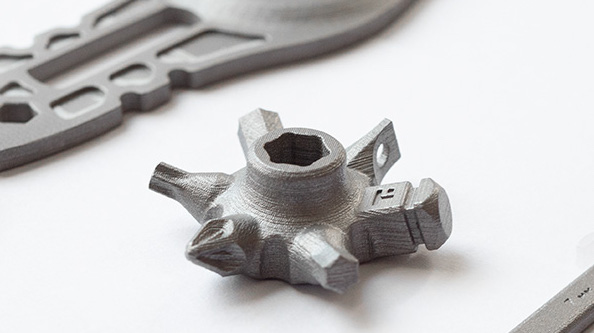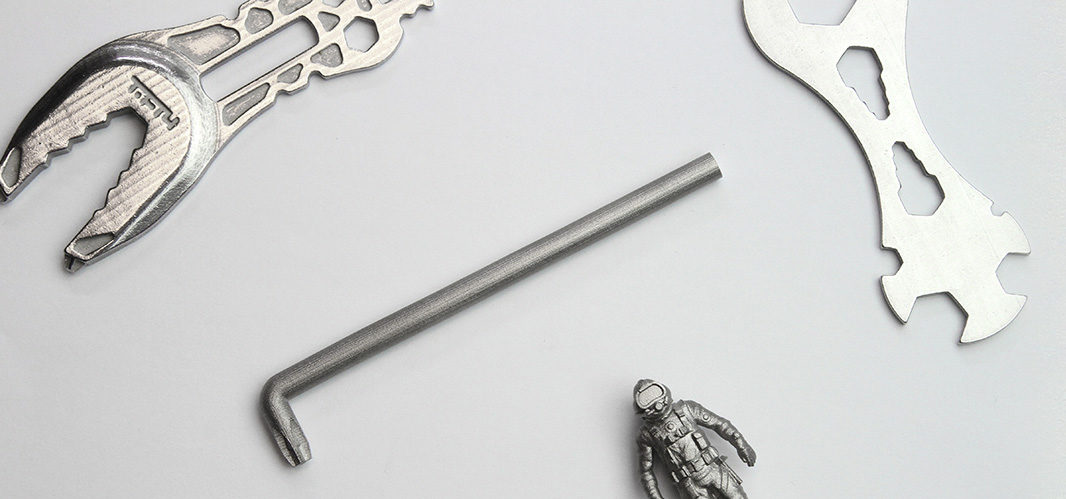
Metal 3D printing allows for innovation like never before, and infinitely so. No matter the scale or volume, designers and engineers can make complex geometries previously impossible with conventional methods; in fact, many traditional manufacturers today provide 3D printing services along with their other offerings, meeting customer demand for new technology as well as allowing them to enjoy the benefits of rapid prototyping, mass customization, and optimization of industrial parts.
Steel 3D Printing with Binder Jetting for Durability in Parts
Shapeways uses Binder Jetting for rapid prototyping as well as fast and efficient 3D printing of high-performance parts. Although the size of the metal powder particles drive features like density, material properties, layer thickness, and resolution, there is the potential for fine detail in parts.
Binder Jetting is a powder-based technology, relying on an ultrasonic dispenser, spreader, and compactor that act as the coating and recoating system. As each layer of powder is deposited, binder liquid is jetted out onto the build plate, serving to adhere the layers together, and eliminating the need for lasers or heat.
No supports are required either, thanks to unsintered powder which stabilizes each part during the 3D printing process. This leads to much greater freedom in design, as intricate support structures do not have to be taken into consideration, or removed later either—decreasing the possibility of any parts being damaged in post-processing. Parts can also be nested, streamlining the print build with packing of parts to reduce the height of the build platform, save in the amount of materials used, and speed up production. Structures of different shapes and sizes can also be placed strategically for printing as well as protecting small or more fragile parts.

Shapeways Offers Several Different Steel 3D Printing Materials
Materials like steel continue to trend upward in 3D printing too for critical applications like automotive, aerospace, and medical—with manufacturers seeking substantial power and strength in metal 3D printing materials, but even more important—lightweight qualities.
This is especially true for manufacturing vehicles with reducing emissions and gas consumption in mind, as well as improving aerodynamics for aircraft or rockets. Steel 3D printing materials are used in a continually expanding range of industries due to resistance to elements like corrosion, chemicals, high and low temperatures, and more.
Shapeways offers the following:
Steel
Made up of a material combination that is 60% steel and 40% bronze, Steel is affordable, strong, and mainly used for tools and accessories, home decor, and smaller industrial consumer goods like bottle openers or gaming dice.
This metal is available in the following colors:
- Bronze
- Gold
- Nickel
- Bronzed-Silver
- Black
A matte finish is available for Steel, featuring an unpolished, rough surface. A polished finish is also offered for shiny, smooth parts; however, note that parts larger than 150 x 150 x 150 or those with thinner details will be finished with bead blasting instead to avoid breakage. This may also present a rougher, less consistent result.
For this material, 3D models must be within the following minimum and maximum bounding box sizes:
- Bounding Box Min
- 6 x 6 x 3 mm
- Bounding Box Max
- 762 x 393 x 393 mm (Bronzed-Silver, Bronze, Black)
- 178 x 178 x 178 mm (Gold, Nickel)
- 152 x 152 x 76 (Polished models)
- 178 x 178 x 178 (Plated models)
Find out more about the design guidelines here.
Stainless Steel 17-4 PH
Stainless Steel 17-4 PH properties are known for hardness and toughness, as well as resistance to heat and corrosion. Parts 3D printed with this single-alloy material usually exhibit superior material properties as well as high resolution.
Shapeways customers rely on Stainless Steel 17-4 PH for industrial manufacturing of:
- Fasteners
- Jigs and fixtures
- Machine tools
- Parts for oil and gas
- Pump components
- Valving
For this material, 3D models must be within the following minimum and maximum bounding box sizes:
- Bounding Box Min
- 15 × 15 × 3 mm
- Bounding Box Max
- 127 × 127 × 76.2 mm
This material is available in silver, with a granular, semi-matte finish that can be polished. Find out more about design guidelines for Stainless Steel 17-4 PH here.
Stainless Steel 316L
Shapeways customers reply on Stainless Steel 316L properties for the following industrial applications:
- Mechanical machinery
- Medical applications like surgical tooling
- Heat exchangers
- Fasteners and brackets
Stainless Steel 316L is available in a natural finish, blasted with ceramic media for a slightly rough surface and a matte finish. It is also offered in a polished finish, with 3D printed parts tumbled for a smooth surface.
For this material, 3D models must be within the following minimum and maximum bounding box sizes:
- Bounding Box Min
- 15 x 15 x 3 mm
- Bounding Box Max
- 127 x 127 x 76.2 mm
This material is available in a natural or polished finish. Find out more about design guidelines for Stainless Steel 316L here.
About Shapeways
Enjoy the benefits of this advanced technology and a wide range of materials from Shapeways for 3D printing your creations with accuracy, complex detail, and no minimum or limits in terms of mass customization or single part orders. Shapeways has worked with over 1 million customers in 160 countries to 3D print over 21 million parts! Read about case studies, find out more about Shapeways additive manufacturing solutions, and get instant quotes here.

